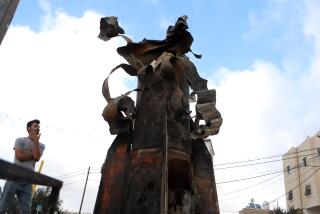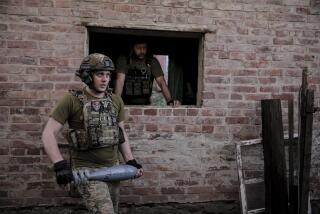Some See Hypocrisy in U.S. Stand on Iraq Arms
WASHINGTON — A decade before the current showdown over weapons of mass destruction, the United States turned a blind eye when Iraq used American intelligence for operations against Iran that made rampant use of chemical weapons and ballistic missiles, according to senior Clinton administration and former intelligence officials.
The attacks against civilian and military targets during the Iran-Iraq War included some of the most pervasive uses of chemical weapons anywhere since World War I.
The combination of Iraq’s weapons of mass destruction and American intelligence eventually helped turn the tide of the eight-year war in Baghdad’s favor. The collaboration reached a peak shortly after a secret U.S. estimate projected for the first time that Iran could win one of the century’s bloodiest wars.
“We knew [the Iraqis] used chemicals in any major campaign,” said a former U.S. intelligence official familiar with the American role. “Although we publicly opposed the use of chemical weapons anywhere in the world, we knew the intelligence we gave the Iraqis would be used to develop their own operational plans for chemical weapons.”
Now, 10 years later, the United States is trying to rally world support for the use of military strikes to destroy the same kinds of Iraqi weapons--on the grounds that Iraqi President Saddam Hussein should not be allowed to use them in the future.
As the U.S. struggles to assemble a new coalition to force Iraq to give up such weapons, administration officials acknowledge the apparent hypocrisy in U.S. policy. The United States, under President Reagan, “virtually encouraged” the use of chemical weapons a decade ago, noted a frustrated senior Clinton administration official.
But the shift also reflects changes in the political landscape, U.S. officials now argue. In the 1980s, “Saddam Hussein was the great white hope” holding back what was then viewed as a militant Islamic tide from Iran, the administration official said. “They built this guy up and let him do whatever it took to win. And that included the use of chemical weapons and ballistic missiles.”
The climax of the relationship was the 1988 Iraqi counterattack at the Faw Peninsula, a swampy but strategic southern oil port captured by Iran in 1986. Iraq lost the peninsula in part because U.S. intelligence misread an Iranian military buildup.
To help regain the peninsula, U.S. intelligence sources provided data on Iran’s equipment and troop strength that guided the Iraqi military in designing and staging a dress rehearsal of the offensive, the sources say. Washington had an “additional incentive” to provide detailed data because of its role in the loss of Faw, a former U.S. diplomat said.
Iraq’s 1988 counterattack was a rapid success. And the casualties were among the grisliest of the war. Thousands of Iranian troops were killed, many because gas masks did not fit snugly enough over their beards and thus allowed seepage of lethal toxins. Empty syringes, some of which had contained a faulty antidote, were found beside hundreds of bodies, the sources said.
The Reagan administration never actively encouraged Iraq’s use of chemical weapons or missiles. And officially, it was neutral in the Iran-Iraq War.
But Washington was well aware that Iraq began using chemical weapons in 1983 and intensified their use in 1986, creating a pattern that made it virtually impossible not to know that Iraq intended to use chemical weapons on the Faw Peninsula, former intelligence officials said.
“By 1986, Iraq had proven itself better at the use of chemical weapons than any fighting force in the world,” said a former senior U.S. diplomat involved in Iraq. By 1988, Iraq’s use of gases had also repeatedly been documented by U.N. specialists.
“It was all done with a wink and a nod,” said a former U.S. intelligence official. “We knew exactly where this stuff was going, although we bent over backwards to look the other way.” Washington knew Iraq was “dumping boatloads” of chemical weapons on Iranian positions, he added.
Missiles were also pivotal in turning the war in Iraq’s favor, especially when Iraq fired Russian-made Scuds on Iranian civilian areas and major cities, including Tehran. The “war of the cities,” during which Iran also targeted Iraq, eventually gave better-equipped Iraq a strong psychological edge in the conflict.
Today, Reagan administration officials contend that they could not have prevented Hussein’s use of weapons of mass destruction.
“Get real. We couldn’t have stopped him,” said a former National Security Council staffer. “The Iraqis were fighting for survival.”
Policy at the time, said another former Reagan official, recognized that “Hussein is a bastard. But at the time, he was our bastard.”
Ironically, the most difficult task initially was persuading the Iraqis to believe U.S. intelligence data.
“We gave them so much help with intelligence in the conduct of overall campaigns--showing them where Iran was moving troops, where it was most vulnerable, and projecting how to exploit both to their advantage,” the former intelligence official said.
At first, Iraq ignored or discarded much of the American data. “It took a long time for them to trust us and listen to us,” the official said. “Eventually, it sunk in that we were telling them what they needed to know.”
The Faw operation was the high point of a blooming relationship between Baghdad and Washington that was founded on a common fear of and deep enmity toward Iran. It overcame more fundamental differences over Israel that led Iraq to sever relations with the U.S. in 1967.
After relations resumed in 1984, U.S. intelligence agents began to provide data about Iran’s military operations, largely from satellite photography. The goal at one stage was to provide a counterweight to the supply of arms and intelligence the Reagan administration was providing to Iran as part of the 1985-86 arms-for-hostages swap, according to Reagan administration officials.
But in 1986, as the Iran-Iraq War began to turn decisively in Iran’s favor, the pace of U.S. intelligence information escalated as part of a bid to at least restore Iraq’s edge.
The United States was not alone. In advance of the Faw counteroffensive, France, Egypt and Jordan provided help in reorganizing and retraining the weary Iraqi military, Reagan administration officials point out.
And the very countries now most threatened by Iraq’s weapons of mass destruction helped pay for them, according to U.S. officials. Of the $100 billion Iraq spent on arms during the 1980s, up to $40 billion was provided by Saudi Arabia, Kuwait and the United Arab Emirates, either in cash or in free oil.
More to Read
Sign up for Essential California
The most important California stories and recommendations in your inbox every morning.
You may occasionally receive promotional content from the Los Angeles Times.










